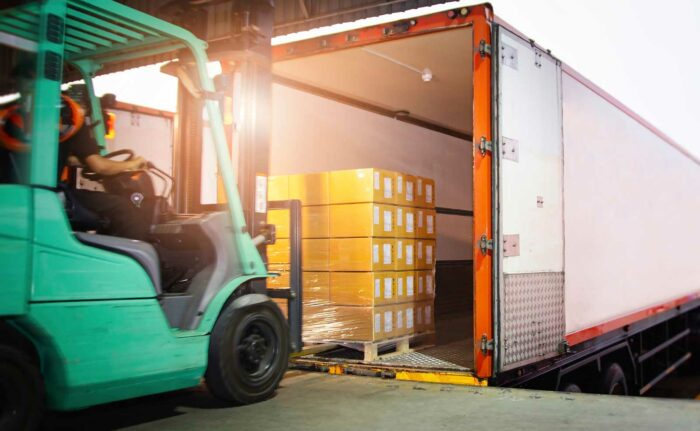
In today’s fast-moving, customer-driven market, supply chains must be more agile, responsive, and cost-effective than ever before. That’s where third-party logistics providers and 3PL warehouse management systems come in. At Made4net, we deliver WMS solutions to 3PL providers so they can stay agile, efficient, and customer-focused. Whether a business is scaling rapidly, expanding into new markets, or simply looking to streamline operations, a 3PL can provide the expertise, technology, and infrastructure to help make it happen. But what exactly is a 3PL, and what do they do?
In this article, we’ll cover:
- What is a 3PL? Third-Party Logistics Definition
- What Does a 3PL Do?
- What is a 3PL Warehouse?
- Why Do Companies Work With a Third-Party Logistics Provider?
- What Are Popular Third-Party Logistics Services?
- What Are the Benefits of Working With a 3PL?
- What Are Examples of 3PL Providers?
- 3PL vs. 4PL
- 3PL vs. Freight Forwarding
- How to Choose a 3PL Provider
What is a 3PL? Third-Party Logistics Definition
A third-party logistics provider, or 3PL, is a company that businesses hire to manage part—or all—of their logistics and supply chain operations. This can include anything from warehousing and transportation to inventory management, fulfillment, and even returns. Rather than investing in their own logistics infrastructure, companies can partner with a 3PL to leverage scalable services, technology, and specialized knowledge that might otherwise be out of reach.
What Does a 3PL Do?
Simply put, a 3PL works as an extension of your business. Services vary depending on the 3PL you partner with, ranging from receiving inventory, storing products, picking and packing orders, shipping to customers, managing returns, and handling freight to managing value-added services, such as kitting, labeling, and real-time tracking.
What is a 3PL Warehouse?
A 3PL warehouse is a facility operated by a third-party logistics provider where a company’s products are stored, processed, and prepared for shipment. But it’s more than just storage space—these warehouses are equipped with technology and systems that enable efficient order processing, inventory tracking, and fulfillment. Using a 3PL warehouse allows businesses to scale more easily, enter new markets faster, and focus on core business activities while leaving logistics to the experts.
Why Do Companies Work With a Third-Party Logistics Provider?
Working with a 3PL offers companies logistics expertise while reducing the burden of managing complex supply chain operations in house. It also helps growing businesses to easily scale up or down based on demand, without having to invest in warehouses, transportation fleets, or extra staff.
3PLs also help businesses reach customers faster by offering strategically located fulfillment centers, established carrier relationships, and optimized shipping strategies. The advanced technologies used by 3PLs—like warehouse management systems (WMS), real-time tracking, and data analytics—provide visibility and control that many companies couldn’t access on their own. For many businesses, the specialized services offered by 3PLs are critical to scaling operations and meeting customer expectations.
What Are Popular Third-Party Logistics Services?
There are countless reasons to partner with a 3PL, but there are a few services offerings that rise to the top as most popular in convincing businesses to work with them.
Warehousing
Product storage is a common challenge for businesses, especially those experiencing rapid growth. A 3PL fulfillment center stores inventory and manages shipping on behalf of the client, taking on the infrastructure burden and allowing businesses to focus on their core operations. This is the 3PL’s area of expertise.
Inventory Management
One of the 3PLs main responsibilities lies in tracking inventory and reporting status back to the company. This provides the company with the information it needs to place new orders for goods based on demand. 3PLs using advanced technology, like Synapse 3PLExpert, can provide real-time inventory management so companies can make informed decisions in real-time.
Order Fulfillment and Handling
Once a customer places an order, the fulfillment process begins. At a 3PL warehouse, this typically starts with picking the item from inventory and preparing it for shipment. Products are carefully packaged and labeled, ready to move through the final stages of delivery. This step covers the operational side of what’s often referred to as “shipping and handling.”
Shipping and Receiving
After packaging, the shipment is labeled and transferred to a carrier for delivery. On the inbound side, the 3PL also manages receiving, ensuring that incoming inventory is properly logged and stored, maintaining accuracy across the supply chain.
Kitting Services
Some orders require multiple items to be grouped and shipped together as a single unit. This is known as kitting. A 3PL can manage the assembly of kits—collecting the necessary components and packaging them as one unit—streamlining fulfillment for bundled products or promotional sets.
Reverse Logistics
When a customer returns an item, a 3PL can handle the entire process. Returned products are received, inspected, and restocked as needed. In addition to managing inventory updates, the 3PL can support the client’s refund process, helping ensure a smooth customer experience while maintaining operational efficiency.
What Are the Benefits of Working With a 3PL?
Working with a third-party logistics provider can be a game changer for most companies, helping them to expand seamlessly, reduce costs, and improve efficiency.
3PL Benefit #1: Cost Reduction
Outsourcing logistics to a 3PL allows businesses to reduce costs associated with warehouse operations and fleet management. It enables them to concentrate on their core competencies while leaving the complexities of logistics to dedicated experts. By leveraging the 3PL’s economies of scale, businesses also gain access to better rates and more efficient processes.
3PL Benefit #2: Risk Mitigation
As experts in risk management, disaster recovery planning, and business continuity, 3PLs can help businesses mitigate supply chain risks. With their extensive network and access to resources, they can easily activate backup transportation plans and flexible routing options to quickly respond to unexpected challenges—like weather events, labor disputes, or supply chain breakdowns—keeping goods moving and customers satisfied.
3PL Benefit #3: Better Logistics Control
Outsourcing logistics to a trusted 3PL partner gives businesses access to the tools, tech, and expertise needed to manage warehousing, transportation, and inventory more effectively. It frees up internal teams to focus on what they do best while keeping operations running smoothly. With real-time visibility and smarter data, companies can make faster, better decisions across the supply chain.
3PL Benefit #4: Improved Efficiency
A 3PL provider brings tools and technologies that streamline every stage of the supply chain—from warehouse operations to last-mile delivery. With smarter routing, better inventory visibility, and integrated systems, companies can reduce delays and eliminate costly inefficiencies.
3PL Benefit #5: Flexibility
Business needs change fast. A 3PL can quickly adapt to seasonal swings, shifting demand, or unexpected disruptions—helping companies scale without sacrificing service.
3PL Benefit #6: Focused Expertise
3PLs live and breathe logistics. Their deep industry knowledge means fewer missteps, faster problem-solving, and a more strategic approach to supply chain execution.
3PL Benefit #7: Wider Reach
With established networks across regions and borders, a 3PL opens the door to new markets. Their carrier relationships and infrastructure make it easier to ship farther, faster, and more cost-effectively.
3PL Benefit #8: Innovation
The best 3PLs are constantly evolving—bringing automation, data insights, and process improvements to the table. That innovation becomes a competitive advantage for the businesses they support.
What Are Examples of 3PL Providers?
For decades, Made4net has delivered powerful warehouse management solutions tailored to the 3PL industry. In 2024, ten Synapse 3PLExpert users were named Top 3PL Providers by Inbound Logistics. Longtime partners like Weber Logistics and Matson Logistics—both leveraging Synapse for over 20 years—were among those honored, alongside leaders such as J.B. Hunt, Kenco, and Ryder System.
3PL Example #1: Law Logistics
Law Logistics is a 6th generation family-owned company with a mission to provide dependable logistics solutions in the Maine, New Hampshire, and Vermont areas. Since 1882 they have focused on providing their customers and employees with value and flexibility.
Looking to replace manual, paper-based processes, Law Logistics turned to Made4net’s Synapse 3PLExpert. Since implementation, they’ve seen improved accuracy, increased efficiency, and ongoing value from the system’s seamless integrations.
3PL Example #2: RS Distribution
Centrally located in Canada, RS Distribution provides secure, efficient distribution networks with a focus on food-grade products. Their advanced systems, modern facilities, and reliable delivery infrastructure offer clients peace of mind.
After outgrowing their previous platform, RS Distribution turned to Made4net’s Synapse 3PLExpert to gain real-time reporting, transparent operations, and precise tracking of logs and expiration dates.
3PL Example #3: Foster Logistics
Foster Logistics began as a real estate company in the 1970s and evolved into a warehousing operation by the 1990s. Today, they serve a wide range of clients with comprehensive logistics services—including storage, sorting, packing and repacking, labeling, and shipping—operating out of more than 4 million square feet of warehouse space in Ohio.
Since implementing Synapse 3PLExpert, Foster Logistics has seen significant gains in inventory control through enhanced barcoding capabilities. With streamlined operations and greater efficiency, they continue to deliver the dependable, high-level service their clients count on.
3PL vs. 4PL
Third-party logistics providers take on the execution of core logistics tasks—things like transportation, warehousing, order fulfillment, inventory management, and returns. They help businesses move goods efficiently and keep operations running smoothly.
Fourth-party logistics (4PL) providers add an additional layer and manage the entire supply chain from end to end. That includes everything from procurement and production planning to distribution strategy and delivery. They often coordinate multiple 3PLs on behalf of the client.
In short: 3PLs handle execution. 4PLs own the strategy and oversight.
3PL vs. Freight Forwarding
A 3PL manages multiple logistics functions under one roof, from warehousing and inventory to fulfillment and transportation. Freight forwarders, on the other hand, specialize in the movement of goods—coordinating shipments across carriers and borders.
How to Choose a 3PL Provider
Ensuring the 3PL provider you choose is the right one for your needs is critical. Similar to a WMS implementation, the last thing you want to do is engage in a partnership only to find it’s not the right fit—that is costly, time-consuming, and has a direct impact on service levels.
A top consideration should be the provider’s technology stack. Robust, modern systems make the difference between real-time visibility and frustrating blind spots. Look for 3PLs who invest in scalable platforms that support integration, automation, and data-driven decision-making. The right technology doesn’t just streamline operations—it empowers smarter service for your customers.
3PLs play a vital role in helping businesses scale, streamline operations, and stay competitive. With solutions like Synapse 3PLExpert, Made4net empowers third-party logistics providers to operate with greater efficiency, visibility, and control—making them even more valuable partners in today’s fast-paced supply chain landscape. If you’re ready to use a 3PL to take your supply chain to the next level, we can help. Reach out today.


